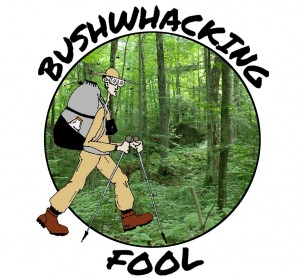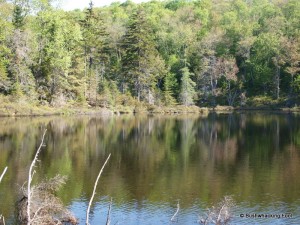
Cropsey Pond
Exploring the Adirondack backcountry is never about comfort. If coziness and comfort is your thing, being sweaty, surrounded by vicious biting flies and exposed to the elements most of the time in the middle of nowhere is probably not your cup tea. Nothing, not even successfully rescuing a lost piece of gear is going to bring you succor at that point.
When I wake in the dead of night with an urgent need to pee, the success of retrieving my stake fails to lift my spirits, especially after sucking in the frigid air into my still groggy lungs. Leaving my relatively warm Western Mountaineering sleeping bag for the cold, Adirondack air is asking a lot, especially with spring well into its middle age. The last thing I expect to see this time of the year is my own breath, let alone my steaming urine. Not even a successful stake rescue at Cropsey Pond the previous day is enough to make up for such chilly temperatures.
However, despite the low temperatures, the spring peepers are still going strong at just after midnight. They serenade me through my entire midnight pee, only to be outdone (in out-of-the-ordinary way, if not volume or intensity) by a saw-whet owl calling in the distance. On the other hand, maybe that owl is just the peeper-induced ringing in my ears.
Crawling back into my sleeping bag for several more hours of slumber, I once again note the uncomfortable ground situation. How could it be so bad now, when I camped at the same site just several weeks before and it did not seem so damn uncomfortable then? Apparently, when it comes to backcountry campsites, inches can make all the difference.
Section Stats:
Date: May 30, 2014
Length: 1.5 miles (1.5 total daily miles; 3.6 total trip miles)
Difficulty: Moderate
My constant discomfort probably explains the drowsiness when seven in the morning comes around and it is time for me to get going. The coolness remains (with it being a degree or two below 50), while despite the sky only being partly cloudy, those clouds are often dark and foreboding. Not surprising, neither the cold nor the clouds do anything to deter the mosquitoes however, which are out in full force.
The bird chorus oscillates between vigorous and non-existent, seemingly changing in an instance. The Birdathon species remain in the area, with just enough new species present now to make me curse under my breath in disgust. I save my greatest derision for the black-backed woodpecker that flies onto a dying fir at the pond’s shoreline. Where was he hiding two weeks ago, I feel like asking him. If only he spoke a lick of English.
After enjoying the birds for a while, I start packing up my campsite for the bushwhack back to Raven Lake Road. While packing away my gear, I reserve the greatest care with taking the tarp down, especially when it comes to retrieving and securing the stakes. Although I enjoy spending time at Cropsey Pond, I do not want to spend my summer perpetually returning to search for tent stakes.
About halfway through packing away my gear, I take a break for breakfast, primarily so I have the energy to fight through the inevitable ingrowth that awaits just south of Cropsey Pond. Once my belly is full, I finish off the packing and prepare myself for the trek back, my purpose for being at Cropsey Pond now complete.
Retracing my steps from the day before, I head off into the forest to the south, soon crossing the old inlet stream on the large beaver dam. The old stream and beaver pond that once fed Cropsey Pond is almost devoid of water now, as if a tectonic plate shifted during an earthquake in the recent path. Then again, perhaps all the new tree growth springing up from the surrounding blowdowns is siphoning off most of the moisture instead.
After crossing the beaver dam, my 110-degree bearing takes me uphill and into that same new hardwood growth from the extensive blowdown caused by the infamous 1995 Microburst storm. The blowdowns are frequent, making the climb away from the Cropsey basin even more arduous and time consuming. The logs, with their upturned root mounds still largely attached, require me to weave through the forest in a serpentine fashion, their great girth making it impossible simply step over with my short legs.
My imagination immediately wanders, reversing time in my mind’s eye and resembling the forest as it once was in all its glory before the derecho moved through nearly twenty years ago. This must have been one pleasant forest to behold.
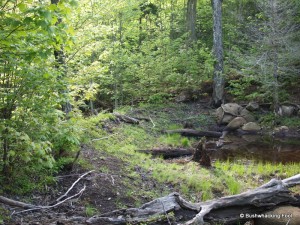
Old beaver dam
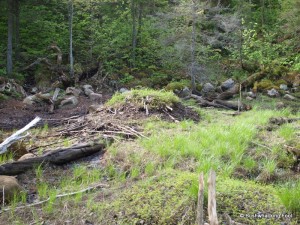
Old beaver lodge
Unfortunately, the forest is now not just a minefield of downed trees, but also an obstacle course of young beech, most likely root sprouts or prodigy of the giants now deceased. This extensive beech regeneration makes the going doubly difficult, with low, young branches continuously striking me or grabbing my backpack, hat and myself. Luckily, my Pinnacle backpack is lean and mean, without any gear hanging off it, unlike the year when I broke one of my homemade hiking poles.
All these hazards makes staying a bearing exceedingly difficult. Either a blowdown is blocking my path or the young trees are so dense requiring all my concentration to squeeze through them, losing all focus on any object off in the distance that I took a bearing on. Finally, the constant necessity of retrieving my compass from within my jacket becomes too frustrating, so I relent and just let it dangle around my neck on its lanyard, occasionally getting caught on a young tree branch, threatening to strangle me in the process.
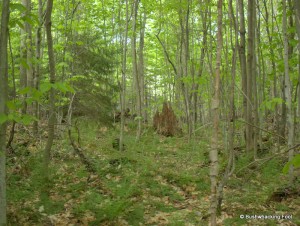
Dense regrowth
After climbing for a while, the new growth and blowdowns start thinning out, giving me a break from all the detouring. Finally, the terrain levels off, giving me an opportunity to take a break for a moment, as that is all the time the ravenous black flies are likely to allow. Soon after starting up again, I pause at a giant yellow birch to marvel at its stature and admire its luck making it through the microburst that killed so many of its compatriots.
At the large tree’s base, a tiny spring peeper jumps into action, hopping away from me as far as his little legs allow. My attempts to take a photograph of the little devil are pointless, his agility thwarting my every move; he is photophobic to say the least. When a hairy woodpecker voices his unhappiness with all the commotion, I give up the chase and move along back on my heading. You just lost your chance to be the centerfold for Amphibian Monthly, bright guy!
A little farther on my bearing and I start descending into a ravine. A small wetland is visible through the forest to the north, with its feeder stream flowing through the bottom of the ravine. Unfortunately, rock cliffs bar my path forward once I enter the ravine, forcing me to head south in search of a way around them.
An agitated broad-winged hawk voices its disapproval of my trespassing, its high-pitched whistle disturbing the relative quiet of the surrounding forest. As I move away from the location, it ceases its calling, and the relative quiet of the forest returns, only the soft sound of a little water flowing through the ravine remains to disturb the stillness of the surroundings.
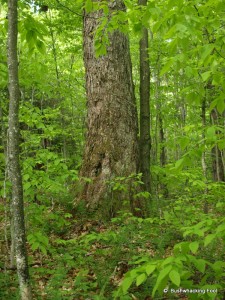
Old man birch
A trickle of flowing water indicates a possible avenue for climbing the rocky cliff, which allows for regaining my bearing without getting too far off course. The cliff has given way here, allowing me to climb up through the debris and gain higher ground. As I thought, a small wetland lies on the other end of the rocky cliff, providing me enough information to locate myself on the USGS map, without the assistance of the GPS currently hanging out in my pocket. Score one for the neo-Luddites!
Once I am able to get back on my bearing after clearing the wetland, the way toward Raven Lake Road appears free of obstacles again. With the wetland at least ten minutes behind me, a seep appears across my path, with a colorful piece of flagging tied to a tree in its center, the orange plastic blowing around in the slight breeze. Stopping and looking around, I see no other flag in any direction. Either the flagging is really far apart, torn down by weather or animals, or this one indicates the shortest trail ever.
The climb away from the small seep ends shortly with a descent into another ravine containing a small stream. After climbing out of this shallow ravine, the terrain commits to a long, steep descent. The forest thins out and the forest floor transitions to open rock for a long stretch. Rubus, moss, ferns and lichen abound along the flat slabs of rock, requiring extra time to avoid stomping on any fragile vegetation.
Unfortunately, the surrounding forest obscures any chance of an outstanding view of the surrounding area, except for the eastern skies. The sky there is dark and foreboding, despite the filtered sunshine coming through overhead. The clouds are not black enough to interfere with a view of a mountain far off in the distance to the northeast though. I know Mount Marcy is visible from the shore of Stillwater Reservoir, so it is not impossible that the highest mountain in the state could be visible here as well.
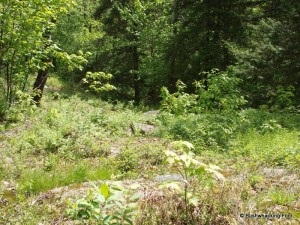
Open rocky descent
The open descent on this rocky gash in the forest soon ends though, leaving me descending at a steady clip through a mature hardwood forest. By now, the terrain is starting to look familiar, so it comes to no surprise when the forest transitions to a coniferous one before I finally end up at the top of a high cliff with no way down in sight.
I have been here before many times. Although going forward on my same bearing appears pretty bleak at this point, experience has taught me that relief is not far to the north, where the cliffs quickly peters out, allowing me to return to my bearing and reach Raven Lake Road without a Herculean effort at rock climbing, or falling to my certain death.
The way north has its own pitfalls though. It is thick with young conifers, requiring me to fight my way through until the cliff disappears entirely. The only positive of the thrashing I receive from the young coniferous branches is that is seems to scare off the majority of black flies, giving my neck and hands a well overdue respite.
After clearing the cliff and crossing a small wetland that feeds its stream, I return to my original bearing and start a modest climb. Luckily, I am shooting for a road that runs north/south, so the chances of missing it even though I lost my bearing for a time are practically nonexistent. As I climb, the forest swiftly transitions from coniferous to hardwood once again, making the going decidedly less arduous.
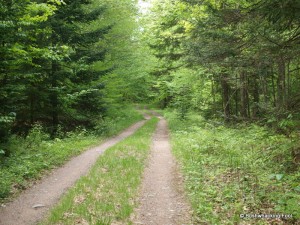
On the road again
When I spot what looks like an unnatural berm running through the forest, my excitement grows, as I know Raven Lake Road is within reach. A climb over the short hill and I exit the forest and step back on the road, just a mile or so north of where I left it yesterday, albeit with a significantly larger horde of black flies buzzing about my head.
To the south lies the trailhead and my waiting car, with all the conveniences of civilization just a short ride away. To the north, is a winding woods road that transitions to a series of meandering old logging roads that spread out into a healing wild land known as the Wilderness Lakes Tract of the Five Ponds Wilderness.
Which way will I choose? It really is never any contest.
Affiliate Disclaimer: Some links within this blog post may send you to a retailer’s website. If you chose to purchase any product on that site, this author may receive a small commission at no extra cost you. These commissions provide compensation for the author’s time and effort necessary to provide the content at the Bushwhacking Fool.
